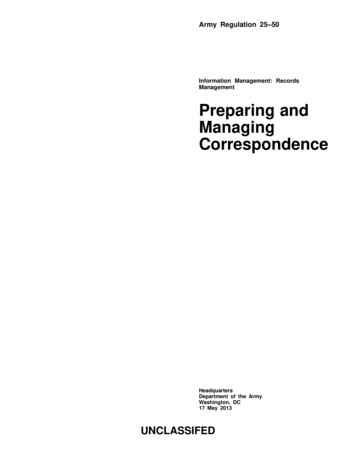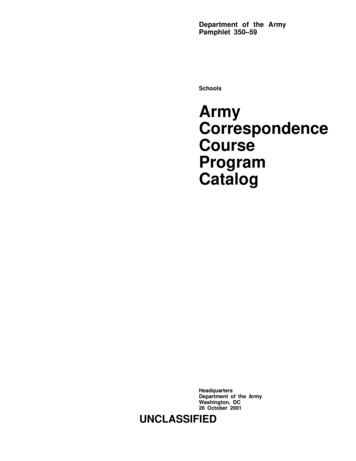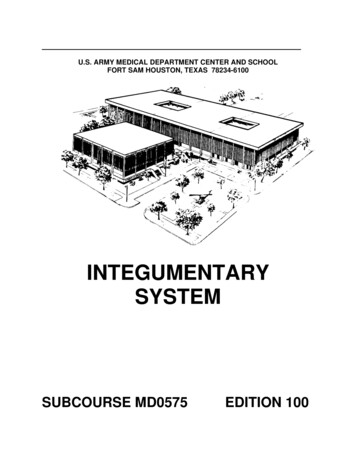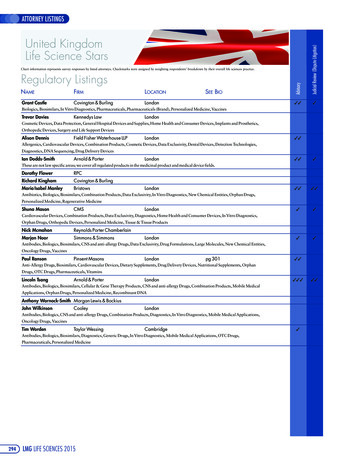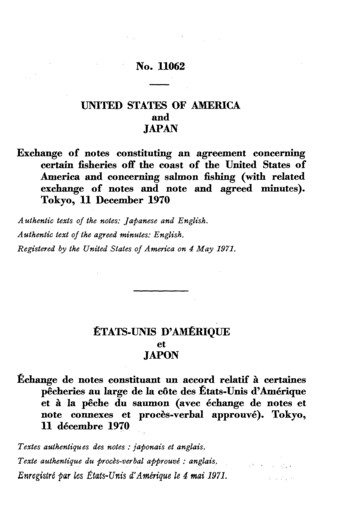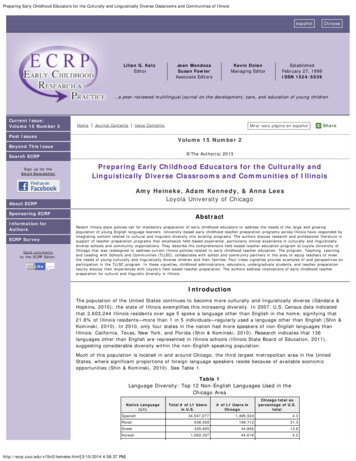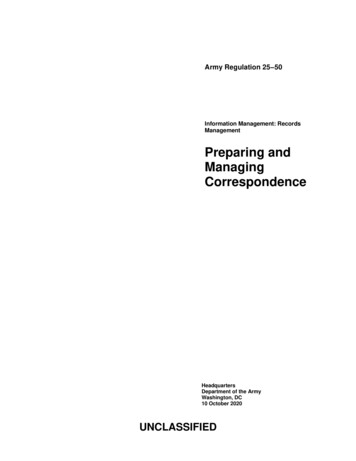
Transcription
Army Regulation 25–50Information Management: RecordsManagementPreparing andManagingCorrespondenceHeadquartersDepartment of the ArmyWashington, DC10 October 2020UNCLASSIFIED
SUMMARY of CHANGEAR 25–50Preparing and Managing CorrespondenceThis major revision, dated 10 October 2020—oInstitutes the requirement for Army Records Information Management System record numbers on memorandums(paras 1–5 and 2–4a(2)(a)).oDirects that correspondence, internal to Army, will be approved via digitally signed documents (paras 1–17 and5–1b(2)(c)).oChanges the order of information when preparing references/citations using parenthesis to indicate titles (para1–30).oChanges the requirement from two spaces after ending punctuation to one space (para 1–39).oRevises memorandum of understanding and memorandum of agreement formats, including sample text (para 2–6,figs 2–15 and 2–16).oAdds the format for a decision memorandum (para 2–8 and fig 2–19).oAdds guidance that Army Records Information Management System record numbers will not be used on letters(para 3–5d).oDirects that digital signatures will not be used on letters (para 3–6c(2)(b)).oAdds instructions for preparing a digital signature using Adobe Pro (paras 5–1b(2), 6–4e, and app F).oRemoves guidance on Army branch title abbreviations and refers users to DA Pamphlet 611 –21.oMakes changes to the DA Form 5 (Army Staffing Form) (para 7–3).oUpdates mass mailing policy (app E).oRemoves the requirement for the Deputy Chief of Staff, G –3/5/7 to incorporate effective Army writing intotraining courses and fund any special requirements (formerly para 1–4).oRemoves the use of Army Knowledge Online and Defense Knowledge Online instant messaging fororganizational and individual information transfer (formerly para 1–7e).oRemoves figures in chapter 8 and refers users to DoD Manual 5200.01, Volume 2 (DoD Information SecurityProgram: Marking of Classified Information) for examples of memorandums with classification markings.
*Army Regulation 25–50HeadquartersDepartment of the ArmyWashington, DC10 October 2020Effective 10 November 2020Information Management : Records ManagementPreparing and Managing CorrespondenceProponent and exception authority.The proponent of this regulation is theAdministrative Assistant to the Secretaryof the Army. The proponent has the authority to approve exceptions or waiversto this regulation that are consistent withcontrolling law and regulations. The proponent may delegate this approval authority, in writing, to members of the SeniorExecutive Service within the proponentagency. Activities may request an exception or waiver to this regulation by providing justification that includes a full analysis of the expected benefits and a formalreview by the activity’s senior legal ofHistory. This publication is a major re- ficer. All requests for exceptions or waivvision.ers will be endorsed by the commander orSummary. This regulation establishes senior leader of the requesting activitythree forms of correspondence authorized and forwarded through their higher headfor use within the Army: a letter, a mem- quarters to the proponent. Refer to AR25–30 for specific guidance.orandum, and a message.Applicability. This regulation appliesto the Regular Army, the Army NationalGuard/Army National Guard of theUnited States, and the U.S. Army Reserve, unless otherwise stated.Army internal control process.This regulation contains internal controlprovisions and provides an internal control evaluation for use in evaluating keyinternal controls (see appendix G).Supplementation. Supplementationof this regulation and establishment ofcommand or local forms are prohibitedwithout prior approval from the Administrative Assistant to the Secretary of theArmy (SAAA), 105 Army Pentagon,Washington, DC 20310 –0105.Suggested improvements. Usersare invited to submit comments and suggested improvements on DA Form 2028(Recommended Changes to Publicationsand Blank Forms) directly to U.S. ArmyRecords Management and Declassification Agency, Records Management Division (AAHS– RDR–SC), 9301 ChapekRd, Building 1458, Fort Belvoir, VA22060–5605.Distribution. This publication is available in electronic media only and is intended for the Regular Army, the ArmyNational Guard/Army National Guard ofthe United States, and the U.S. Army Reserve.Contents (Listed by paragraph and page number)Chapter 1Preparing Correspondence, page 1Section IGeneral, page 1Purpose 1–1, page 1References and forms 1–2, page 1Explanation of abbreviations and terms 1–3, page 1Responsibilities 1–4, page 1Records management (recordkeeping) requirements 1–5, page 1Restrictions to this regulation 1–6, page 1Objectives 1–7, page 1Section IIGeneral Correspondence Guidance, page 2Methods of communication 1–8, page 2Direct communications 1–9, page 2Routing through channels 1–10, page 2Writing quality 1–11, page 2*This regulation supersedes AR 25-50, dated 17 May 2013.AR 25–50 10 October 2020UNCLASSIFIEDi
Contents—ContinuedExclusive For correspondence 1–12, page 2Section IIISpecific Correspondence Guidance, page 3Dissemination of command instructions 1–13, page 3Unique capitalization 1–14, page 3Abbreviations, brevity codes, and acronyms 1–15, page 3Letterhead 1–16, page 3Digital signatures 1–17, page 4Paper 1–18, page 4Type fonts and sizes 1–19, page 4Ink color 1–20, page 4Copies 1–21, page 4Classified and special handling correspondence 1–22, page 4Identifying a point of contact 1–23, page 5Identifying the originating office 1–24, page 5Expressing a date 1–25, page 5Expressing time 1–26, page 5Suspense date 1–27, page 5Addressing 1–28, page 5Postscripts 1–29, page 5References 1–30, page 5Page and paragraph numbering 1–31, page 6Using boldface and italic type for emphasis 1–32, page 6Distribution formulas 1–33, page 6Identifying and listing enclosures 1–34, page 6Nine-digit ZIP code (ZIP 4 code) 1–35, page 6North Atlantic Treaty Organization correspondence 1–36, page 7Recordkeeping requirements for delegations of signature authority 1–37, page 7Section IVEffective Writing and Correspondence: The Army Writing Style, page 7Standards for Army writing 1–38, page 7Constructing military correspondence 1–39, page 7Chapter 2Preparing Memorandums, page 7General 2–1, page 7Use 2–2, page 7General rules 2–3, page 8Format 2–4, page 8Multiple-page memorandums 2–5, page 9Memorandum of understanding or memorandum of agreement 2–6, page 10Memorandum for record 2–7, page 10Decision memorandum 2–8, page 11Chapter 3Preparing Letters, page 38General 3–1, page 38Use 3–2, page 38Response phrases 3–3, page 38Abbreviations 3–4, page 38General rules 3–5, page 38Format 3–6, page 38AR 25–50 10 October 2020ii
Contents—ContinuedChapter 4Listing Enclosures, Placing Tabs, and Assembling Correspondence, page 46General 4–1, page 46Enclosures 4–2, page 46Tabbing enclosures 4–3, page 47Tabbing correspondence packages 4–4, page 47Chapter 5Processing Correspondence and Official Mail, page 49Section ICost Reduction Methods, page 49Reducing mail costs 5–1, page 49Disseminating correspondence via messenger envelopes 5–2, page 49Section IIEnvelopes, page 49Size 5–3, page 49Folding and fastening 5–4, page 49Mailing 5–5, page 49Section IIIAddressing Mail, page 50Delivery address 5–6, page 50Return address 5–7, page 50Addressing 5–8, page 50Address format 5–9, page 50Address content 5–10, page 51“To the Commander of ” 5–11, page 52Chapter 6Preparing Authority Lines, Signatures, and Signature Blocks, page 53Section IDelegation of Authority, page 53Delegation of signature authority 6–1, page 53Delegation of authority line 6–2, page 53Section IISignatures and Signature Blocks, page 54Signatures 6–3, page 54Signature block 6–4, page 54Personnel on active duty 6–5, page 55Retired military personnel 6–6, page 56Army Reserve personnel not on active duty 6–7, page 57Civilian personnel and contract surgeons 6–8, page 57Signatures of subordinates 6–9, page 57Auto-pen signature 6–10, page 57Chapter 7Using Prescribed Forms and Labels, page 57General 7–1, page 57Routing and transmittal slips 7–2, page 57Department of the Army Form 5 7–3, page 57Department of the Army Form 200 7–4, page 58Department of the Army Form 209 7–5, page 58Department of the Army Label 87 7–6, page 58AR 25–50 10 October 2020iii
Contents—ContinuedDepartment of the Army Label 113 7–7, page 58Department of the Army Label 115 7–8, page 58Optional Form 65–B or standard sized Interdepartmental Delivery Envelopes 7–9, page 58Optional Form 65–C or legal sized Interdepartmental Delivery Envelopes 7–10, page 58Chapter 8Marking Classified Correspondence, page 58General authority 8–1, page 58Cover sheets 8–2, page 58AppendixesA. References, page 59B. Titles and Protocol Sequence, page 62C. Forms of Address, Salutation, and Complimentary Close, page 64D. Model Authority Lines and Signature Blocks, page 80E. Preparing Mass Mailings, page 92F. Creating an Adobe Digital Signature on a Microsoft Word Document Using Adobe Pro, page 93G. Internal Control Evaluation, page 94Table ListTable 4–1: Three Enclosures, page 46Table 4–2: Four enclosures, page 46Table 4–3: One enclosure, page 46Table 4–4: Two or more enclosures, page 46Table 4–5: Two enclosures, page 47Table 4–6: Five enclosures, page 47Table 5–1: Address format, page 50Table 5–2: Return address format, page 50Table 5–3: United States Postal Service two-letter State or territory abbreviations, page 51Table 5–4: Example of “To the Commander of ”, page 52Table 6–1: Army grade abbreviations, page 55Table C–1: The Executive Branch, page 64Table C–2: The Congress and legislative agencies, page 67Table C–3: The Judiciary, page 68Table C–4: Military Personnel, page 68Table C–5: State and Government Officials, page 72Table C–6: Ecclesiastical officials, page 74Table C–7: Private citizens, page 76Table C–8: Corporations, companies, and federations, page 76Table C–9: Foreign government officials, page 77Table C–10: International organizations, page 77Table C–11: Additional former officials, page 78Figure ListFigure 2–1: Using and preparing a memorandum with a digital signature, page 12Figure 2–2: Preparing a two page memorandum with a suspense date, page 14Figure 2–2: Preparing a two page memorandum with a suspense date---Continued, page 14Figure 2–3: Addressing a single-address Headquarters, Department of the Army Memorandum, page 15Figure 2–4: Addressing a single-address Army service component command memorandum, page 16Figure 2–5: Addressing a multiple-address memorandums for Headquarters, Department of the Army agencies usingfull titles and addresses with a digital signature, page 17AR 25–50 10 October 2020iv
Contents—ContinuedFigure 2–6: Addressing a multiple-address memorandums for Headquarters, Department of the Army agencies usingoffice symbols, page 18Figure 2–7: Addressing an Army command multiple-address memorandums with digital signature, page 19Figure 2–8: Preparing a SEE DISTRIBUTION addressed memorandum, page 21Figure 2–8: Preparing a SEE DISTRIBUTION addressed memorandum---Continued, page 21Figure 2–9: Preparing a DISTRIBUTION list on the second page, page 23Figure 2–9: Preparing a DISTRIBUTION list on the second page---Continued, page 23Figure 2–10: Preparing a memorandum with a distribution formula, page 24Figure 2–11: Preparing a single-address MEMORANDUM THRU, page 25Figure 2–12: Preparing a MEMORANDUM THRU with two addresses, page 26Figure 2–13: Preparing a one-paragraph memorandum with subparagraphs and continuing the subject line, page 27Figure 2–14: Listing enclosures, copies furnished, and point of contact paragraph, page 28Figure 2–15: Preparing a memorandum of understanding, page 30Figure 2–15: Preparing a memorandum of understanding---Continued, page 30Figure 2–16: Preparing a memorandum of agreement, page 32Figure 2–16: Preparing a memorandum of agreement---Continued, page 32Figure 2–17: Preparing a memorandum for record, page 33Figure 2–18: Preparing a decision memorandum, page 35Figure 2–18: Preparing a decision memorandum---Continued, page 35Figure 2–19: Preparing a digital decision memorandum, page 37Figure 2–19: Preparing a digital decision memorandum---Continued, page 37Figure 3–1: Formatting a letter, page 41Figure 3–1: Formatting a letter---Continued, page 41Figure 3–2: Using office symbols and titles, page 42Figure 3–3: Spacing in a letter, page 43Figure 3–4: Preparing a letter with a subject line, page 44Figure 3–5: Using courtesy copy in letters, page 45Figure 4–1: Tabbing correspondence, page 48Figure B–1: Protocol sequence for addressing the Office of the Secretary of Defense, page 62Figure B–2: Protocol order for addressing Headquarters, Department of the Army principal officials, page 63Figure D–1: Signed by the commanding general, page 80Figure D–2: Signed by an authorized subordinate of the commander, page 81Figure D–3: Signed by the head of a Headquarters, Department of the Army Staff agency, page 81Figure D–4: Signed by an authorized representative of the Headquarters, Department of the Army staffagency, page 82Figure D–5: Signed by the commanding officer of a unit, headquarters, or installation, page 82Figure D–6: Signed by an authorized representative of the commander of a unit, headquarters, or installation, page 83Figure D–7: Signed by an authorized representative for the head or staff office or other official, page 84Figure D–8: Signed by an authorized civilian, with or without an authority line, page 85Figure D–9: Signature of an officer writing as an individual (show name, grade, branch, and organization), page 85Figure D–10: Examples of signature blocks for letters (show the name in uppercase and lowercase letters, grades,U.S. Army spelled out, and organization), page 86Figure D–11: Signature blocks for retired military personnel, page 86Figure D–12: Abbreviated titles, page 87Figure D–13: Unabbreviated titles, page 87Figure D–14: Noncommissioned officer signature blocks, page 88Figure D–15: Signed by an enlisted U.S. Army Reserve Soldier on active duty, such as during an Active Guard Reserve Assignment, page 88Figure D–16: Signed by a U.S. Army Reserve officer on active duty, page 88Figure D–17: Signed by an officer assigned to the general staff, colonel, or below, page 89Figure D–18: Signed by an officer detailed as inspector general, page 89Figure D–19: Signed by a medical corps officer, page 89Figure D–20: Signed by a reserve noncommissioned officer not on active duty, page 90Figure D–21: Signed by a reserve officer not on active duty, page 90Figure D–22: Signed by a reserve warrant officer, page 90AR 25–50 10 October 2020v
Contents—ContinuedFigure D–23: Signed by an active duty U.S. Army Reserve chaplain (such as during an Active Guard Reserve assignment), page 91Figure D–24: Signed by a U.S. Army Reserve chaplain not on active duty, page 91GlossaryAR 25–50 10 October 2020vi
Chapter 1Preparing CorrespondenceSection IGeneral1–1. PurposeThis regulation prescribes Department of the Army (DA) policies, procedures, and standard formats for preparing andprocessing Army correspondence.1–2. References and formsSee appendix A.1–3. Explanation of abbreviations and termsSee the glossary.1–4. Responsibilitiesa. The Administrative Assistant to the Secretary of the Army (AASA) will—(1) Establish policies and procedures for preparing correspondence on behalf of the Secretary of the Army(SECARMY).(2) Develop policy and direction for correspondence management for DA.b. Headquarters, Department of the Army (HQDA) principal officials and commanders or heads of Army commands (ACOMs), Army service component commands (ASCCs), direct reporting units (DRUs), installations, activities, and units will supervise and manage correspondence within their agencies or commands and will actively supporteffective Army writing by enforcing prescribed standards for all Army personnel.1–5. Records management (recordkeeping) requirementsThe records management requirement for all record numbers, associated forms, and reports required by this regulationare addressed in the Records Retention Schedule-Army (RRS–A). Detailed information for all related record numbers,forms, and reports are located in the Army Records Information Management System (ARIMS)/RRS –A athttps://www.arims.army.mil. If any record numbers, forms, and reports are not current, addressed, and/or publishedcorrectly in ARIMS/RSA–A, see DA Pam 25–403 for guidance.1–6. Restrictions to this regulationThis regulation has been made as complete as possible to avoid issuing additional instructions. The formats for correspondence outlined in this regulation take precedence over format instructions outlined in other regulations or directives. Therefore, command publications issued to augment this regulation will be restricted to instructions that areunique to the issuing command.Note. When preparing correspondence for signature by the Secretary of Defense; Secretary of the Army; Chief of Staffof the Army; Under Secretary of the Army; Vice Chief of Staff of the Army; Assistant Secretaries of the Army; AASA;and other HQDA principal officials, follow the guidance in DA Memorandum 25 –52 and Department of Defense(DoD) 5110.04–M–V–1.1–7. ObjectivesThe objectives of this regulation are to—a. Provide clear instructions for preparing correspondence.b. Reduce the cost of preparing correspondence.c. Standardize the preparation and dissemination of correspondence.AR 25–50 10 October 20201
Section IIGeneral Correspondence Guidance1–8. Methods of communicationa. Personal or telephone contact. Conduct official business by personal contact, telephone, or Defense SwitchedNetwork (DSN), whenever possible. Use a memorandum for record (MFR) to document any decisions or agreementsreached during voice communications (see para 2–7 for the proper use of an MFR).b. Memorandum. Use the memorandum for correspondence within a department or agency, as well as for routinecorrespondence to Federal Government agencies outside DoD. Do not use the memorandum format when corresponding with the Families of military personnel or private businesses (see para 2–2 for the proper use of the memorandum).c. Letter. Use the letter for correspondence addressed to the President or Vice President of the United States,members of the White House staff, Members of Congress, Justices of the Supreme Court, heads of departments andagencies, State Governors, mayors, foreign government officials, and the public. You may also use letters to addressindividuals outside the department or agency when a personal tone is appropriate, such as in letters of commendationor condolence (see para 3–2 for the proper use of a letter).d. Electronic mail. Use email to transfer organizational and individual information.1–9. Direct communicationsSend correspondence as directly as possible to the action office concerned (see para 2–4a(5)). Include the actionofficer’s name and office symbol when addressing correspondence.1–10. Routing through channelsa. Routing action correspondence. Route correspondence through commands, agencies, or offices expected to exercise control or take action.b. Bypassing intermediate headquarters. Do not route correspondence through a headquarters that has no concernin the matter or action. However, send a copy of the communication and referral action to the command, agency, oroffice that was bypassed. Routine correspondence may bypass intermediate headquarters when—(1) It is apparent the intermediate headquarters is not concerned.(2) No action is required.(3) No controls need to be exercised.c. Using technical channels. Use technical channels to route correspondence that deals with technical matters.This includes technical reports, instructions, or requests for information that do not involve command matters. Beforeusing technical channels, mak
three forms of correspondence authorized for use within the Army: a letter, a mem-orandum, and a message. 25 Applicability. Army internal control process. This regulation applies to the Regular Army, the Army National Guard/Army National Guard of
